Roadbuilding: The road to recovery
25 November 2020

A UK road surfaced with MacRebur’s recycled plastic binder added to the traditional asphalt mix
Major road construction contracts are never easy to come by and are always hard won.
The award of a lucrative roads contract generally comes as the result of many years of experience and a combination of skill sets in the design team and workforce that enable the contractor to be precise about the challenges, timescale, equipment and, of course, costs involved.
In terms of challenges, today’s projects are more complex than ever before, given the new normal of social distancing and additional pressures of ensuring the work is undertaken sustainably.
Swiss recycling
In Ariolo, a municipality in the Swiss Alps, Ammann is working on a €240 million project to completely renovate a 10km stretch of the N2 motorway. The work is due to be completed in 2022, but challenges include the fact that the current road base consists of material created during the excavation of the nearby Gotthard Base tunnel – the aggregate has a fine-grain content of more than 8%, meaning it is not frost-resistant.
The project is proceeding under the auspices of the Federal Roads Office (Astra), which has stipulated that the materials that form the current road base be processed on site and reused in the new asphalt mix.
In addition to this, however, the project planners calculated that 55,000 tonnes of gravel would be required, as well as almost 400,000 tonnes of asphalt, of which 140,000 tonnes would be reclaimed.
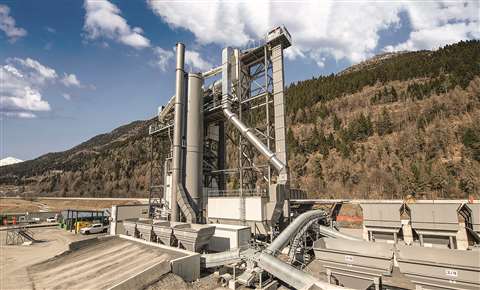
Under normal circumstances, the project would have required 25,000 truck journeys of 70km, to bring the material to the site.
For this reason, an area beside the motorway was provided for asphalt preparation and production. On the site – a former military airfield – an asphalt crushing plant, asphalt mixing plant and a gravel washing plant were all installed.
Ammann, which supplied the asphalt-mixing plant for the project, says the 250,000 tonnes of asphalt being produced at the site is proof that it is possible to use high percentages of recycled materials without the use of rejuvenation agents and without any loss of quality.
The ABP HRT mixing plant (with HRT meaning high recycling technology) is designed to be able to handle material with a high proportion of recycled asphalt.
An integrated, parallel drum system above the mixer optimises the material flow and minimises wear and tear within the recycling system.
In the RAH100 system, the recycled asphalt is heated by a counter-current process. Rocks and bitumen are indirectly and evenly heated and protected from overheating.
Ammann says the plant can produce between 240 and 310 tonnes per hour of asphalt depending on moisture levels.
Use, reuse, recycle
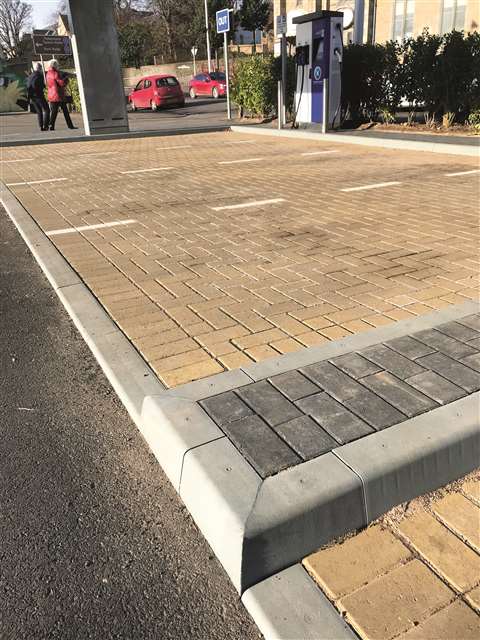
Recycling is also a buzz word on a roads project in Wokingham in the UK, where the local borough council has awarded a contract to VolkerHighways, to install kerbs made from 88% recycled plastic.
Each unit of Durakerb, produced by Dura Products, contains the equivalent of 182 plastic bottles, but the environmental benefits of using the product also include the release of less CO2 during its manufacturer and the need for fewer vehicles to deliver the lighter material.
A spokesperson for Wokingham Borough Council, which is aiming to be carbon neutral by 2030, said, “Using plastic kerbs reduces the amount of carbon produced in manufacturing, transport and construction by about 40%.”
According to Dura, on-site efficiency is also increased when using Durakerb, as only one operative is required for installation, due to it being significantly lighter than standard kerbing, and to the ease with which the material can be cut.
The company adds that reduced need for machinery in the installation has health and safety benefits for those on site.
Steve Bennett, managing director at Dura Products, said, “The trial in Wokingham is an excellent step towards making the borough’s highway maintenance more environmentally friendly,” but adds, “The benefits of Durakerb go beyond its sustainability advantages and we hope Wokingham council will continue their use for the foreseeable future.”
As most people, certainly in the construction industry, are now probably aware, the waste created by construction and demolition projects accounts for between 25 and 30% of all waste generated in the European Union. That’s an extremely unattractive statistic for the industry, especially given the volumes of construction materials that could be recycled.
But things are undoubtedly changing for the better.
Reusing waste responsibly
For example, another UK firm is utilising waste plastic in the construction of the roads themselves.
MacRebur turns plastic back into its oil-based state, before using it as a binder in the asphalt mix.
In this way, the company says, there are no microplastics present. Furthermore, says MacRebur, when the road surface reaches the end of its life, the plastic in it can be recycled again.

The process begins with the selection of certain types of polymers – gathered from landfill following its commercial and domestic use – which are then ground down before being blended with an activator, which allows it bind into the asphalt mix.
Once added to the mix by the asphalt producer, the resultant material is ready to applied to the road using standard road surfacing equipment.
The company says the equivalent of 684,000 plastic bottles, or 1.8 million plastic bags are used in each km of road paved with the MacRebur asphalt mix.
There are, however, many more ways to make road construction more sustainable and one of them is through the use of technology, which has been proven to boost efficiency and reduce waste, when used effectively.
Optimising equipment
The fast and efficient transportation and transfer of materials on road construction sites has the potential to significantly reduce waste, and Germany’s Vögele, part of the Wirtgen group, now promises a constant, smooth transfer of material with its MT 3000-3i Standard and MT 3000-3i Offset PowerFeeders.
The company says the machines’ AutoSet Plus automatic functions make it as easy as a button-push to put the material feeder in the transport, repositioning or operating positions – or to save material handling programs and call the settings up again whenever they are required.

This, says Vögele, is particularly useful on job sites which require frequent repositioning or have similar paving requirements.
For material transfer, the optional PaveDock Assistant communication system allows the operator to use two signal lights to show the truck driver clearly whether he is to back up, stop or dump mix.
If the InLine Pave method is in use, the signal lights also indicate whether material for the surface course or the binder course is required. This allows reliable and, importantly, loss-free and efficient material transfer.
Vögele says the material handling concept of the new machines has also been optimised, with a redesigned receiving hopper, plus improvements to the conveyor belt control and belt heating system allowing material to be unloaded and conveyed rapidly and without loss.
Maintenance and transport have likewise been simplified: users can now reach setting and cleaning points even more conveniently. The angle of inclination and the receiving hopper have also been optimized for transport on a low-loader.
For further increased efficiency on job sites, both versions of the material feeder are able to achieve a conveying capacity of up to 1,200 tonnes per hour and can accommodate a full truckload of mix within 60 seconds.
Controlled efficiency
Staying on the theme of efficiency, Cat released its Command for Compaction operator-assisted technology in March this year, driving forward the automation of the soil compaction process.
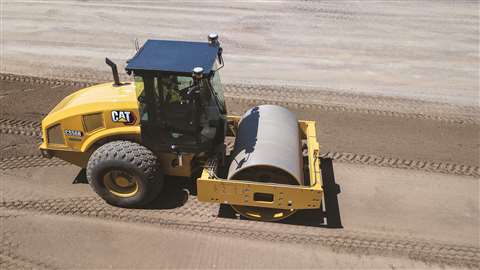
According to Cat, the system, available on select Cat vibratory soil compactors, produces consistent results based on operator inputs, which could benefit companies struggling to find operators with the requisite skills to deliver high-quality results using traditional methods.
For example, once the boundaries of an area to be compacted, along with the compaction parameters, the machine can
be set to automatic mode, at which point the system is in control of the travel, steering and vibration of the machine.
The Command software can also instantly recall recent job data.
Command for Compaction aids with constant speed and accurate pass count (with precise overlap data), increasing the likelihood of compaction targets being met or exceeded.
Trimble launches Roadworks 2D
Technology firm Trimble has launched its Roadworks 2D Paving Control Platform for asphalt paving.
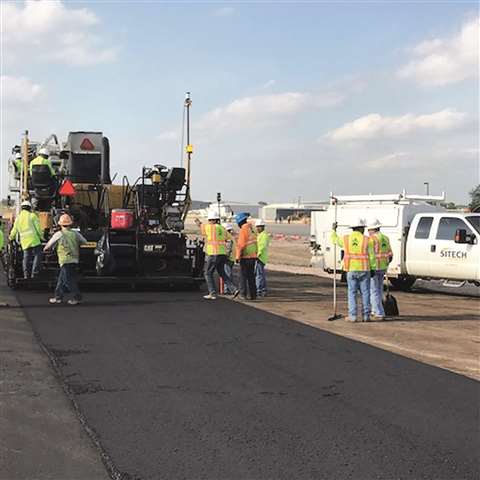
Trimble says the new system can help contractors reduce both asphalt waste and project time, while improving finishes.
As opposed to the 3D Paving Control system, which allows paving with variable depth and slope, the 2D version helps paving to a fixed thickness, after they have been graded or milled using 3D machine control.
Each side of the paver is typically equipped with one sonic tracer or with three sonic tracers mounted on an averaging beam. These tracers send signals to reference off the existing surface and calculate an average elevation for paving a smooth surface.
Those already familiar with its technology, says Trimble, will find the Roadworks 2D platform intuitive and straightforward to operate, as the software uses the same interface as the company’s Earthworks Grade Control Platform and launches from the Android operating system.
Kevin Garcia, general manager for Trimble Civil Specialty Solutions, said, “This new platform leverages the intuitive Trimble machine control interface and applies it to asphalt pavers, making it easy to use and learn, and more accessible for many different types of contractors.”
Phil Foley vice president of Operations at Austin Materials and Industrial Asphalt & Aggregates, which has been using the new system, said, ”Having automatic grade control on our pavers just eliminates the near misses and potential safety hazards, along with extra work that takes time. Now, our guys can just zero in and focus on getting to grade and tolerances quickly and producing the smoothest surface possible.”
Roll on electrification
Many industry observers have reported that the coronavirus crisis is causing an acceleration of uptake in and awareness of construction technology.
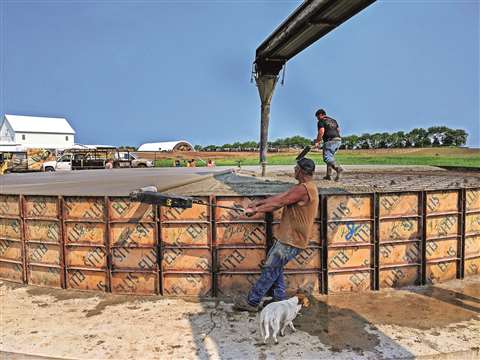
Electrified equipment has now reached a stage in its development where it doesn’t cost the earth to buy, can operate as efficiently (if not more) than its diesel counterparts, and produces no local emissions.
Compact excavators made the first in-roads into construction, but now other machines are following. One within the road construction arena is Curb Roller’s Batt Screed 6000, the industry’s first battery-powered roller screed. The machine is powered by a rechargeable 60V lithium ion DeWalt battery, which promises to screed up to more than 230m on a charge.
The Batt Screed can handle jobs of up to 670cm and Curb Roller says, the concrete being spun into shape – as opposed to vibrating it – means more of the larger aggregate remain close to the surface of the slab, increasing its structural integrity.
Three diggers, three days
German contractor Beller was recently tasked with demolishing a 100-year-old road bridge, before constructing its replacement.
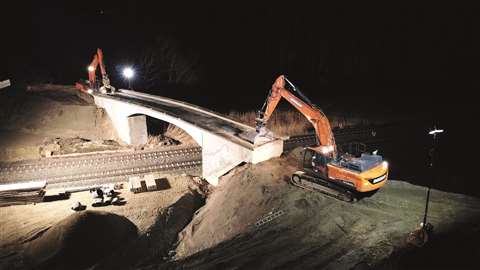
As the bridge passed over a railway line, which would have to be out of service during the replacement project, Beller was given an incredible deadline of just 72 hours to complete the work.
With a plan to continue operations round the clock, Beller employed three Doosan excavators – a DX255LC-5, a DX340LC-5 and a DX380LC-5 – to create a gravel bed to protect the railway track’s bedding, ahead of the demolition work.
To make things a little more challenging, Beller had to be particularly careful about a main data line that runs through the construction site area – and connects a large part of the region to the Internet.
The clock started ticking at midnight, when the rail operations were stopped, and the CX340LC-5 and the DX255LC-5 excavators, working with pulverisers, chisels and grabs, tackled the old foundations. The DX380LC-5 worked on the superstructure.
During the demolition operation, approximately 800 tonnes of concrete was removed, to be reused in Beller’s own reprocessing plants.
After 72 gruelling hours, the construction work was completed and the route was opened to traffic. To complete the project, the Doosan excavators were subsequently used for earthworks applications and the loading of trucks.
Doosan’s excavators worked round the clock on a 72-hour deadline
The road to net zero carbon
As the country progresses towards its ambitious goal of achieving net zero carbon release by the year 2050, councils have been using the lockdown period to provide road networks with a face-lift, introducing initiatives aimed at making roads more environmentally friendly.
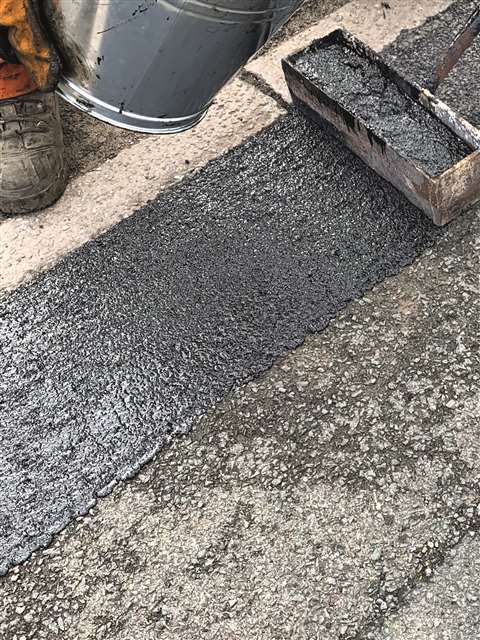
These have included:
- Integrated cycle lane expansion in London, helping an increase of cyclists by 120% in the city
- The opening of the UK’s first ‘Dutch-style’ cycling roundabout
- First proposals for a nationwide ‘e-highways’ network, alleviating HGV emissions
- Pop-up cycle lanes with pavement extensions to focus on greater pedestrianisation of city centres
Working with councils for new, sustainable and cost-effective potholes repairs, Roadmender Asphalt has been at the forefront of road upgrades with councils across the UK.
Harry Pearl, CEO of Roadmender Asphalt, said of the vision of councils to upgrade road provisions, “After a decade of austerity, councils have naturally gravitated towards innovation and have helped launch R&D hubs, working with innovative SMEs.
“Together, SMEs and councils have started to ask why road improvement tasks can’t now be fulfilled with innovative and modern practices. We are now finding with councils that these innovations are trickling down into all aspects of road upgrades.
Pothole repairs were traditionally filled with the same materials made to build roads. Now however, we can fill potholes with materials made specifically for the job, that may prove to be significantly more efficient and cost-effective.”
This article first appeared in the November/December issue of Construction Europe magazine.
Click here to subscribe for FREE and receive every digital issue of the magazine.




